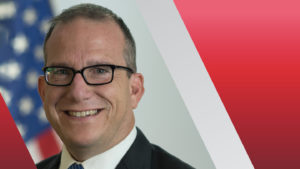
NASHVILLE, TN — Providers renewed their concerns about staffing constraints, workforce retention and the survey process during a rare live forum with a top Centers for Medicare & Medicaid Services leader Tuesday.
David Wright, director of the Quality Safety & Oversight Group at CMS, fielded provider questions on a range of topics during the second full day of the 73rd annual American Health Care Association/National Center for Assisted Living convention. The session was billed as both a way for CMS to gather feedback and to help providers prepare for a wave of new regulation.
“It’s important for us to hear directly from nursing homes as we transition out of the pandemic and refocus on some of the things that we were focused on before the pandemic,” Wright told McKnight’s Long-Term Care News after the session.
He said questions about the ongoing temporary nurse aide waiver process dominated much of the conversation, and he encouraged providers to work with their states if they continue to struggle with certification delays.
After the members-only session, attendees told McKnight’s that key topics of discussion included a proposed staffing minimum currently being studied by the agency, improved data sharing and transparency efforts, and the lack of clinical representation among surveyors.
Wright “emphasized that CMS values transparency, data sharing and improved communication with providers as a pathway toward improved survey compliance,” said Yvonne Choong, director of government affairs with the California Association of Health Facilities. “Session participants had the opportunity to ask questions and brought forth concerns about constraints that they face, including workforce retention and recruitment challenges and the lack of state surveyors with clinical training.”
Multiple sources said the session was congenial but at times frank. The audience broke out in laughter several times.
“It was definitely respectful both ways,” said Chris Puri, an attorney with Bradley Arant Boult Cumming LLP in Nashville and former counsel to the Tennessee Health Care Association.
“Regarding the upcoming staffing mandate rule, several providers in the audience asked fair but direct questions about whether CMS was going to consider the reality that SNFs may not be able to recruit and hire sufficient employees to meet whatever mandate CMS comes up with,” Puri reported, noting that Wright said CMS would consider such comments when they are filed in response to a proposed staffing rule.
While Puri said Wright told providers CMS was well aware of the nursing shortage — mentioning the agency’s own struggles to hire — he acknowledged that CMS had been given a directive to pursue the staffing rule.
Staffing at crux of CMS concerns
Wright encouraged providers to remain part of the conversation as multiple new skilled nursing rules kick in, starting later this month with new surveyor guidance for the Rules of Participation.
“The session was informative and we appreciate CMS publicly stating their commitment to transparency, data sharing, and seeking to incorporate feedback from LTC providers in policy development, and taking actions toward these goals,” Choong said.
She added that the staffing minimum was a major concern of providers given significant challenges and providers’ inability to improve compliance if they have no workers to hire, there was little discussion of how the rule itself might be shaping up.
Some owners and operators this week have discussed their ideas on what would be needed to make a minimum achievable. Nate Schema, president and CEO of The Evangelical Lutheran Good Samaritan Society, told McKnight’s he supports inclusion of a waiver in the rule for facilities that can prove severe hiring hardships.
“Our biggest concern is that we’ll get something that’s one-size-fits-all,” he said, noting his organization has about 2,000 openings systemwide. “We can’t find people today, so the thought of layering on a 4.1 [nursing hours per patient per day standard] could have a devastating consequence on a rural community. … I just don’t see it as sustainable.”
Others continue to advocate for an approach that incorporates non-nursing staff, such as therapists and activity directors into any calculations.
There was no discussion during Wright’s session about specific staffing level targets or which staff might be counted in the rule, Choong noted.




